An AHP-SWOT-Fuzzy TOPSIS Approach for Achieving a Cross-Border RES Cooperation
Abstract
1. Introduction
1.1. Background and Motivation
1.2. Contributions
- How can we exploit the most from the regions’ strengths to increase the cumulative welfare of both EU and the regional countries?
- How can we circumvent the regions´ weaknesses by choosing the best technology options?
- How can we create opportunities and then capitalize on them?
- How can we manage possible threats, so that the RES targets will not be compromised by unfavorable evolution?
1.3. Decision Support Methods Review
1.3.1. SWOTAnalysis
1.3.2. AHP
1.3.3. FuzzyTOPSIS
1.4. Manuscript Organisation
2. Materials and Methods
2.1. Overview of the Proposed Methodology
- helping Europe achieve (or overfull fill) its RES targets in a cost-effective way, and
- helping developing countries deploy RES, firstly, to meet their increasing energy needs and, secondly, for exports to the EU.
- SO: Strategy that uses the internal strengths to take advantage of opportunities.
- ST: Strategy that uses the strengths to minimize threats.
- WO: Strategy that improves weaknesses by taking advantage of opportunities.
- WO: Strategy that tries to eliminate weaknesses to avoid threats.
2.2. Implementation Steps of the Proposed Methodology
3. Application: The Case of Morocco
3.1. Overview of Morocco’s Current Situation
3.1.1. Energy Profile
3.1.2. Investment Profile
3.1.3. Socio-Environmental Profile
3.2. Application of the Proposed Methodology
4. Discussion
5. Conclusions
6. Patents
Author Contributions
Funding
Conflicts of Interest
Abbreviations and Variable Definitions
| AHP | Analytic Hierarchy Process |
| AMEE | Agence Marocaine pour l’ Efficacité Énergétique |
| ANP | Analytic Network Process |
| ANRE | National Agency for Regulation of Electricity |
| BETTER | Bringing Europe and Third countries closer together through renewable Energies |
| BRI | Belt and Road Initiative |
| CNG | Compressed Natural Gas |
| CPF | Country Partnership Framework |
| CSP | Concentrated Solar Power |
| EC | European Commission |
| EETC | Egyptian Electricity Transmission Company |
| FDI | Foreign Direct Investment |
| Fuzzy TOPSIS | Fuzzy Technique for Order of Preference by Similarity to Ideal Solution |
| GHG | Greenhouse Gasses |
| GIS | Geographic Information System |
| IPCC | Intergovernmental Panel on Climate Change |
| IRESEN | Institute for Research in Solar Energy and Renewable Energies |
| MASEN | Moroccan Agency for Sustainable Energy |
| MCDM | Multi-Criteria Decision Making |
| NIS | Negative Ideal Solution |
| ONEE | Office National de l’ Électricité et de l’ Eau Potable |
| PIS | Positive Ideal Solution |
| RECAI | Renewable Energy Country Attractiveness Index |
| RED | Renewable Energy Directive |
| RES | Renewable Energy Sources |
| RES-E | RES electricity |
| SWOT | Strengths, Weaknesses, Opportunities, Threats |
| The normalisation of the square matrix : | |
| The fuzzy decision matrix | |
| The distance of alternatives from FNIS | |
| The distance of alternatives from FPIS | |
| The normalized fuzzy decision matrix | |
| The weighted normalized fuzzy decision matrix | |
| The weights of the criteria | |
| The square matrix that is developed from the pairwise comparison of the criterion i with the criterion j | |
| C | The set of the evaluation criteria |
| CC | Closeness Coefficient |
| CI | Consistency Index |
| CR | Consistency Ratio |
| FNIS | The fuzzy negative ideal solution |
| FPIS | The fuzzy positive ideal solution |
| RI | Random Index |
| λmax | The principal eigen value of the matrix |
References
- Doukas, H.; Nikas, A. Decision Support Models in Climate Policy. Eur. J. Oper. Res. 2020, 280, 1–24. [Google Scholar] [CrossRef]
- European Commision. Clean Energy for All Europeans; COM(2016) 860 Final: Brussels, Belgium, 2016; p. 13. [Google Scholar]
- European Commision. Directive (EU) 2018/2001 of the European Parliament and of the Council of 11 December 2018 on the Promotion of the Use of Energy from Renewable Sources; Official Journal of the European Union: Luxembourg, 2018; p. 128. [Google Scholar]
- Klinge Jacobsen, H.; Pade, L.L.; Schröder, S.T.; Kitzing, L. Cooperation Mechanisms to Achieve EU Renewable Targets. Renew. Energy 2014, 63, 345–352. [Google Scholar] [CrossRef]
- Karakosta, C.; Marinakis, V.; Psarras, J. RES Cooperation Opportunities between EU and MENA Countries: The Case of Morocco. Energy Strateg. Rev. 2013, 2, 92–99. [Google Scholar] [CrossRef]
- Papapostolou, A.; Karakosta, C.; Nikas, A.; Psarras, J. Exploring Opportunities and Risks for RES-E Deployment under Cooperation Mechanisms between EU and Western Balkans: A Multi-Criteria Assessment. Renew. Sustain. Energy Rev. 2017, 80, 519–530. [Google Scholar] [CrossRef]
- Karakosta, C.; Marinakis, V.; Papapostolou, A.; Psarras, J. Benefits and costs sharing through RES electricity cooperation between Europe and third countries. In Proceeding of the 3rd International Conference on Energy Systems and Technologies, Cairo, Egypt, 16–19 February 2015. [Google Scholar]
- Papapostolou, A.; Karakosta, C.; Marinakis, V.; Flamos, A. Assessment of RES Cooperation Framework between the EU and North Africa. Int. J. Energy Sect. Manag. 2016, 10, 402–426. [Google Scholar] [CrossRef]
- Karakosta, C.; Papapostolou, A.; Dede, P.; Marinakis, V.; Psarras, J. Investigating EU-Turkey Renewable Cooperation Opportunities: A SWOT Analysis. Int. J. Energy Sect. Manag. 2016, 10, 337–362. [Google Scholar] [CrossRef]
- Papapostolou, A.; Karakosta, C.; Doukas, H. Analysis of Policy Scenarios for Achieving Renewable Energy Sources Targets: A Fuzzy TOPSIS Approach. Energy Environ. 2017, 28, 88–109. [Google Scholar] [CrossRef]
- Papapostolou, A.; Karakosta, C.; Kourti, K.-A.; Doukas, H.; Psarras, J. Supporting Europe’s Energy Policy Towards a Decarbonised Energy System: A Comparative Assessment. Sustainability 2019, 11, 4010. [Google Scholar] [CrossRef]
- Cinelli, M.; Coles, S.R.; Kirwan, K. Analysis of the Potentials of Multi Criteria Decision Analysis Methods to Conduct Sustainability Assessment. Ecol. Indic. 2014, 46, 138–148. [Google Scholar] [CrossRef]
- Kumar, A.; Sah, B.; Singh, A.R.; Deng, Y.; He, X.; Kumar, P.; Bansal, R.C. A Review of Multi Criteria Decision Making (MCDM) towards Sustainable Renewable Energy Development. Renew. Sustain. Energy Rev. 2017, 69, 596–609. [Google Scholar] [CrossRef]
- Lee, H.-C.; Chang, C.-T. Comparative Analysis of MCDM Methods for Ranking Renewable Energy Sources in Taiwan. Renew. Sustain. Energy Rev. 2018, 92, 883–896. [Google Scholar] [CrossRef]
- Şengül, Ü.; Eren, M.; Eslamian Shiraz, S.; Gezder, V.; Şengül, A.B. Fuzzy TOPSIS Method for Ranking Renewable Energy Supply Systems in Turkey. Renew. Energy 2015, 75, 617–625. [Google Scholar] [CrossRef]
- Stein, E.W. A Comprehensive Multi-Criteria Model to Rank Electric Energy Production Technologies. Renew. Sustain. Energy Rev. 2013, 22, 640–654. [Google Scholar] [CrossRef]
- Wang, J.-J.; Jing, Y.-Y.; Zhang, C.-F.; Zhao, J.-H. Review on Multi-Criteria Decision Analysis Aid in Sustainable Energy Decision-Making. Renew. Sustain. Energy Rev. 2009, 13, 2263–2278. [Google Scholar] [CrossRef]
- Kousksou, T.; Allouhi, A.; Belattar, M.; Jamil, A.; El Rhafiki, T.; Zeraouli, Y. Morocco’s Strategy for Energy Security and Low-Carbon Growth. Energy 2015, 84, 98–105. [Google Scholar] [CrossRef]
- Helms, M.M.; Nixon, J. Exploring SWOT Analysis—Where Are We Now? J. Strateg. Manag. 2010, 3, 215–251. [Google Scholar] [CrossRef]
- Chiu, A.S.; Yong, G. On the Industrial Ecology Potential in Asian Developing Countries. J. Clean. Prod. 2004, 12, 1037–1045. [Google Scholar] [CrossRef]
- Terrados, J.; Almonacid, G.; Hontoria, L. Regional Energy Planning through SWOT Analysis and Strategic Planning Tools. Renew. Sustain. Energy Rev. 2007, 11, 1275–1287. [Google Scholar] [CrossRef]
- Zharan, K.; Bongaerts, J.C. Decision-Making on the Integration of Renewable Energy in the Mining Industry: A Case Studies Analysis, a Cost Analysis and a SWOT Analysis. J. Sustain. Min. 2017, 16, 162–170. [Google Scholar] [CrossRef]
- Jaber, J.O.; Elkarmi, F.; Alasis, E.; Kostas, A. Employment of Renewable Energy in Jordan: Current Status, SWOT and Problem Analysis. Renew. Sustain. Energy Rev. 2015, 49, 490–499. [Google Scholar] [CrossRef]
- Chen, W.-M.; Kim, H.; Yamaguchi, H. Renewable Energy in Eastern Asia: Renewable Energy Policy Review and Comparative SWOT Analysis for Promoting Renewable Energy in Japan, South Korea, and Taiwan. Energy Policy 2014, 74, 319–329. [Google Scholar] [CrossRef]
- Dyson, R.G. Strategic Development and SWOT Analysis at the University of Warwick. Eur. J. Oper. Res. 2004, 152, 631–640. [Google Scholar] [CrossRef]
- Lei, Y.; Lu, X.; Shi, M.; Wang, L.; Lv, H.; Chen, S.; Hu, C.; Yu, Q.; da Silveira, S.D.H. SWOT Analysis for the Development of Photovoltaic Solar Power in Africa in Comparison with China. Environ. Impact Assess. Rev. 2019, 77, 122–127. [Google Scholar] [CrossRef]
- Agyekum, E.B.; Ansah, M.N.S.; Afornu, K.B. Nuclear Energy for Sustainable Development: SWOT Analysis on Ghana’s Nuclear Agenda. Energy Rep. 2020, 6, 107–115. [Google Scholar] [CrossRef]
- Kamran, M.; Fazal, M.R.; Mudassar, M. Towards Empowerment of the Renewable Energy Sector in Pakistan for Sustainable Energy Evolution: SWOT Analysis. Renew. Energy 2020, 146, 543–558. [Google Scholar] [CrossRef]
- Igliński, B.; Iglińska, A.; Koziński, G.; Skrzatek, M.; Buczkowski, R. Wind Energy in Poland – History, Current State, Surveys, Renewable Energy Sources Act, SWOT Analysis. Renew. Sustain. Energy Rev. 2016, 64, 19–33. [Google Scholar] [CrossRef]
- Ervural, C.B.; Zaim, S.; Demirel, O.F.; Aydin, Z.; Delen, D. An ANP and Fuzzy TOPSIS-Based SWOT Analysis for Turkey’s Energy Planning. Renew. Sustain. Energy Rev. 2018, 82, 1538–1550. [Google Scholar] [CrossRef]
- Wang, Y.; Xu, L.; Solangi, Y.A. Strategic Renewable Energy Resources Selection for Pakistan: Based on SWOT-Fuzzy AHP Approach. Sustain. Cities Soc. 2020, 52, 101861. [Google Scholar] [CrossRef]
- Khan, M.I. Evaluating the Strategies of Compressed Natural Gas Industry Using an Integrated SWOT and MCDM Approach. J. Clean. Prod. 2018, 172, 1035–1052. [Google Scholar] [CrossRef]
- Solangi, Y.A.; Tan, Q.; Mirjat, N.H.; Ali, S. Evaluating the Strategies for Sustainable Energy Planning in Pakistan: An Integrated SWOT-AHP and Fuzzy-TOPSIS Approach. J. Clean. Prod. 2019, 236, 117655. [Google Scholar] [CrossRef]
- Velasquez, M.; Hester, P.T. An Analysis of Multi-Criteria Decision Making Methods. Int. J. Oper. Res. 2013, 10, 56–66. [Google Scholar]
- Badri, M.A. A Combined AHP–GP Model for Quality Control Systems. Int. J. Prod. Econ. 2001, 72, 27–40. [Google Scholar] [CrossRef]
- Wang, B.; Song, J.; Ren, J.; Li, K.; Duan, H.; Wang, X. Selecting Sustainable Energy Conversion Technologies for Agricultural Residues: A Fuzzy AHP-VIKOR Based Prioritization from Life Cycle Perspective. Resour. Conserv. Recycl. 2019, 142, 78–87. [Google Scholar] [CrossRef]
- Ghimire, L.P.; Kim, Y. An Analysis on Barriers to Renewable Energy Development in the Context of Nepal Using AHP. Renew. Energy 2018, 129, 446–456. [Google Scholar] [CrossRef]
- Ozdemir, S.; Sahin, G. Multi-Criteria Decision-Making in the Location Selection for a Solar PV Power Plant Using AHP. Measurement 2018, 129, 218–226. [Google Scholar] [CrossRef]
- Colak, H.E.; Memisoglu, T.; Gercek, Y. Optimal Site Selection for Solar Photovoltaic (PV) Power Plants Using GIS and AHP: A Case Study of Malatya Province, Turkey. Renew. Energy 2020, 149, 565–576. [Google Scholar] [CrossRef]
- Keeley, A.R.; Matsumoto, K. Relative Significance of Determinants of Foreign Direct Investment in Wind and Solar Energy in Developing Countries—AHP Analysis. Energy Policy 2018, 123, 337–348. [Google Scholar] [CrossRef]
- Wu, Y.; Xu, C.; Ke, Y.; Tao, Y.; Li, X. Portfolio Optimization of Renewable Energy Projects under Type-2 Fuzzy Environment with Sustainability Perspective. Comput. Ind. Eng. 2019, 133, 69–82. [Google Scholar] [CrossRef]
- Karakosta, C.; Psarras, J. Fuzzy TOPSIS approach for understanding a country’s development priorities within the scope of climate technology transfer. In Advances in Energy Research; Acosta, M.J., Ed.; Nova Science Publishers: Hauppauge, NY, USA, 2012; Volume 9, pp. 123–149. ISBN 978-1-61470-485-0. [Google Scholar]
- Hwang, C.L.; Yoon, K. Multiple Attribute Decision Making: Methods and Applications a State-of-the-Art Survey; Springer: Berlin/Heidelberg, Germany, 1981; ISBN 978-3-540-10558-9. [Google Scholar]
- Zadeh, L.A. Fuzzy Sets. Inf. Control 1965, 8, 338–353. [Google Scholar] [CrossRef]
- Kahraman, C.; Onar, S.C.; Oztaysi, B. Fuzzy Multicriteria Decision-Making: A Literature Review. Int. J. Comput. Intell. Syst. 2015, 8, 637–666. [Google Scholar] [CrossRef]
- Bellman, R.E.; Zadeh, L.A. Decision-Making in a Fuzzy Environment. Manag. Sci. 1970, 17, B-141–B-164. [Google Scholar] [CrossRef]
- Karakosta, C. Multi-Criteria Decision Making Methods for Technology Transfer; LAP LAMBERT Academic Publishing: Riga, Latvia, 2018; ISBN 978-613-9-86527-7. [Google Scholar]
- Khalili-Damghani, K.; Sadi-Nezhad, S.; Tavana, M. Solving Multi-Period Project Selection Problems with Fuzzy Goal Programming Based on TOPSIS and a Fuzzy Preference Relation. Inf. Sci. 2013, 252, 42–61. [Google Scholar] [CrossRef]
- Lima Junior, F.R.; Osiro, L.; Carpinetti, L.C.R. A Comparison between Fuzzy AHP and Fuzzy TOPSIS Methods to Supplier Selection. Appl. Soft Comput. 2014, 21, 194–209. [Google Scholar] [CrossRef]
- Zhao, H.; Guo, S. Selecting Green Supplier of Thermal Power Equipment by Using a Hybrid MCDM Method for Sustainability. Sustainability 2014, 6, 217–235. [Google Scholar] [CrossRef]
- Papadogeorgos, I.; Papapostolou, A.; Karakosta, C.; Doukas, H. Multicriteria assessment of alternative policy scenarios for achieving EU RES target by 2030. In Strategic Innovative Marketing; Kavoura, A., Sakas, D., Tomaras, P., Eds.; Springer Proceedings in Business and Economics; Springer: Cham, Switzerland, 2017. [Google Scholar]
- Rani, P.; Mishra, A.R.; Mardani, A.; Cavallaro, F.; Alrasheedi, M.; Alrashidi, A. A Novel Approach to Extended Fuzzy TOPSIS Based on New Divergence Measures for Renewable Energy Sources Selection. J. Clean. Prod. 2020, 257, 120352. [Google Scholar] [CrossRef]
- Çolak, M.; Kaya, İ. Prioritization of Renewable Energy Alternatives by Using an Integrated Fuzzy MCDM Model: A Real Case Application for Turkey. Renew. Sustain. Energy Rev. 2017, 80, 840–853. [Google Scholar] [CrossRef]
- Karunathilake, H.; Hewage, K.; Mérida, W.; Sadiq, R. Renewable Energy Selection for Net-Zero Energy Communities: Life Cycle Based Decision Making under Uncertainty. Renew. Energy 2019, 130, 558–573. [Google Scholar] [CrossRef]
- Ligus, M.; Peternek, P. Determination of Most Suitable Low-Emission Energy Technologies Development in Poland Using Integrated Fuzzy AHP-TOPSIS Method. Energy Procedia 2018, 153, 101–106. [Google Scholar] [CrossRef]
- Proctor, T. Strategic Marketing, an Introduction, 1st ed.; Taylor & Francis Ltd.: London, UK, 2008. [Google Scholar]
- Weihrich, H. The TOWS Matrix—A Tool for Situational Analysis. Long Range Plan. 1982, 15, 54–66. [Google Scholar] [CrossRef]
- Chen, C.-T. Extensions of the TOPSIS for Group Decision-Making under Fuzzy Environment. Fuzzy Sets Syst. 2000, 114, 1–9. [Google Scholar] [CrossRef]
- Chen, S.; Wei, Z. A Rational Consensus Model in Group Decision Making based on Linguistic Assessment Information. In Proceeding of the International Conference on Management and Service Science (MASS), Wuhan, China, 24–26 August 2010. [Google Scholar]
- Alptekin, N. Integration of SWOT Analysis and TOPSIS Method in Strategic Decision Making Process. Macrotheme Rev. 2013, 2, 1–8. [Google Scholar]
- Saaty, T.L. Decision Making with the Analytic Hierarchy Process. Int. J. Serv. Sci. 2008, 1, 83. [Google Scholar] [CrossRef]
- World Future Council. A Roadmap for 100% Renewable Energy in Morocco; World Future Council: Hamburg, Germany, 2017. [Google Scholar]
- Bouhal, T.; Agrouaz, Y.; Kousksou, T.; Allouhi, A.; El Rhafiki, T.; Jamil, A.; Bakkas, M. Technical Feasibility of a Sustainable Concentrated Solar Power in Morocco through an Energy Analysis. Renew. Sustain. Energy Rev. 2018, 81, 1087–1095. [Google Scholar] [CrossRef]
- Lotfi, M.; Monteiro, C.; Shafie-khah, M.; Catalao, J.P.S. Evolution of Demand Response: A Historical Analysis of Legislation and Research Trends. In Proceeding of the 2018 Twentieth International Middle East Power Systems Conference (MEPCON), Cairo University, Cairo, Egypt, 18–20 December 2018. [Google Scholar]
- Cantoni, R.; Rignall, K. Kingdom of the Sun: A Critical, Multiscalar Analysis of Morocco’s Solar Energy Strategy. Energy Res. Soc. Sci. 2019, 51, 20–31. [Google Scholar] [CrossRef]
- GIZ. No Étude de l’effet sur l‘Emploi d’un Régime D’autoproduction avec Facturation nette D’électricité (Loi 13-09 et loi 58-15) issue D’installations Photovoltaïques Connectées au Réseau de Basse Tension au Maroc; Deutsche Gesellschaft für Internationale Zusammenarbeit (GIZ) GmbH: Eschborn, Germany, 2017. [Google Scholar]
- OECD/IEA. Renewables 2018. Available online: www.iea.org/statistics/ (accessed on 12 March 2020).
- Renewable Energy Solutions for the Mediterranean (RES4MED). Country Profile: Morocco 2018. Available online: https://www.res4med.org/wp-content/uploads/2018/06/Country-profile-Marocco-2.pdf (accessed on 12 March 2020).
- Moore, S. Evaluating the Energy Security of Electricity Interdependence: Perspectives from Morocco. Energy Res. Soc. Sci. 2017, 24, 21–29. [Google Scholar] [CrossRef]
- Nordea. Country Profile Morocco. Available online: https://www.nordeatrade.com/en/explore-new-market/morocco/investment (accessed on 3 March 2020).
- IEA. Energy Policies Beyond IEA Countries: Morocco 2019; OECD: Paris, France, 2019; Available online: https://doi.org/10.1787/10f93028-en (accessed on 12 March 2020).
- Schinke, B.; Klawitter, J. Summary: Country Fact Sheet Morocco, Energy and Development at a Glance, Middle East North Africa Sustainable ELECtricity Trajectories (MENA-SELECT) Project; Germanwatch: Bonnn, Germany, 2016. [Google Scholar]
- OECD/ΙΕA. World Energy Balances 2018. Available online: www.iea.org/statistics/ (accessed on 12 March 2020).
- Schwerhoff, G.; Sy, M. Financing Renewable Energy in Africa—Key Challenge of the Sustainable Development Goals. Renew. Sustain. Energy Rev. 2017, 75, 393–401. [Google Scholar] [CrossRef]
- Warren, B. Renewable Energy Country Attractiveness Index (RECAI). Available online: https://www.ey.com/en_uk/power-utilities/renewable-energy-country-attractiveness-index (accessed on 12 March 2020).
- Schinko, T.; Komendantova, N. De-Risking Investment into Concentrated Solar Power in North Africa: Impacts on the Costs of Electricity Generation. Renew. Energy 2016, 92, 262–272. [Google Scholar] [CrossRef]
- Royaume du Maroc Ministere de I’lndustrie. Industrial Acceleration Plan 2014–2020. Available online: http://www.mcinet.gov.ma/en/content/industrial-acceleration-plan-2014-2020-0 (accessed on 12 March 2020).
- Choukri, K.; Naddami, A.; Hayani, S. Renewable Energy in Emergent Countries: Lessons from Energy Transition in Morocco. Energy. Sustain. Soc. 2017, 7, 25. [Google Scholar] [CrossRef]
- Schinko, T.; Bohm, S.; Komendantova, N.; Jamea, E.M.; Blohm, M. Morocco’s Sustainable Energy Transition and the Role of Financing Costs: A Participatory Electricity System Modeling Approach. Energy. Sustain. Soc. 2019, 9, 1. [Google Scholar] [CrossRef]
- Tramblay, Y.; Ruelland, D.; Bouaicha, R.; Servat, E. Projected climate change impacts on water resources in northern Morocco with an ensemble of regional climate models. Hydrology in a Changing World: Environmental and Human Dimensions. In Proceeding of the FRIEND-Water 2014, Montpellier, France, 7–10 October 2014. IAHS Publ. 363. [Google Scholar]
- Simonneaux, V.; Cheggour, A.; Deschamps, C.; Mouillot, F.; Cerdan, O.; Le Bissonnais, Y. Land Use and Climate Change Effects on Soil Erosion in a Semi-Arid Mountainous Watershed (High Atlas, Morocco). J. Arid Environ. 2015, 122, 64–75. [Google Scholar] [CrossRef]
- Kousksou, T.; Allouhi, A.; Belattar, M.; Jamil, A.; El Rhafiki, T.; Arid, A.; Zeraouli, Y. Renewable Energy Potential and National Policy Directions for Sustainable Development in Morocco. Renew. Sustain. Energy Rev. 2015, 47, 46–57. [Google Scholar] [CrossRef]
- The World Bank. Morocco Overview. Available online: https://www.worldbank.org/en/country/morocco/overview#2 (accessed on 12 March 2020).
- Trieb, F.; Hess, D.; Kern, J.; Fichter, T.; Moser, M.; Pfenning, U.; Caldez, N.; de la Rua, C.; Türk, A.; Frieden, D.; et al. WP3:North Africa Case Study Final Report Bringing Europe and Third Countries Closer Together through Renewable Energies (BETTER) Project, European Commission Intelligent Energy for Europe; Contract No: IEE/11/845/SI2.61637; European Commission: Brussels, Belgium, 2015. [Google Scholar]
- Davies, M.; Elmatbouly, S.; El-Mazghouny, D.; Schellkens, G.; Ahmad, S. Developing Renewable Energy Projects: A Guide to Achieving Success in the Middle East. Available online: https://www.pwc.com/m1/en/publications/documents/developing-renewable-energy-projects-egypt.pdf (accessed on 3 April 2020).
- Rady, Y.Y.; Rocco, M.V.; Serag-Eldin, M.A.; Colombo, E. Modelling for Power Generation Sector in Developing Countries: Case of Egypt. Energy 2018, 165, 198–209. [Google Scholar] [CrossRef]
- Elkadeem, M.R.; Wang, S.; Azmy, A.M.; Atiya, E.G.; Ullah, Z.; Sharshir, S.W. A Systematic Decision-Making Approach for Planning and Assessment of Hybrid Renewable Energy-Based Microgrid with Techno-Economic Optimization: A Case Study on an Urban Community in Egypt. Sustain. Cities Soc. 2020, 54, 102013. [Google Scholar] [CrossRef]
- Davies, M.; Hodge, B.; Ahmad, S.; Wang, Y. Developing Renewable Energy Projects: A Guide to Achieving Success in the Middle East. Available online: https://www.pwc.com/m1/en/publications/documents/eversheds-pwc-developing-renewable-energy-projects.pdf (accessed on 3 April 2020).
- Bohl, D.K.; Hanna, T.; Scott, A.C.; Moyer, J.D.; Hedden, S.G. Sustainable Development Goals Report: Egypt 2030; Frederick S. Pardee Center for International Futures and United Nations Development Programme: Denver, CO, USA; New York, NY, USA, 2018. [Google Scholar]
- IRENA. Renewable Energy Outlook: Egypt, Executive Summary; International Renewable Energy Agency: Abu Dhabi, United Arab Emirate, 2018. [Google Scholar]
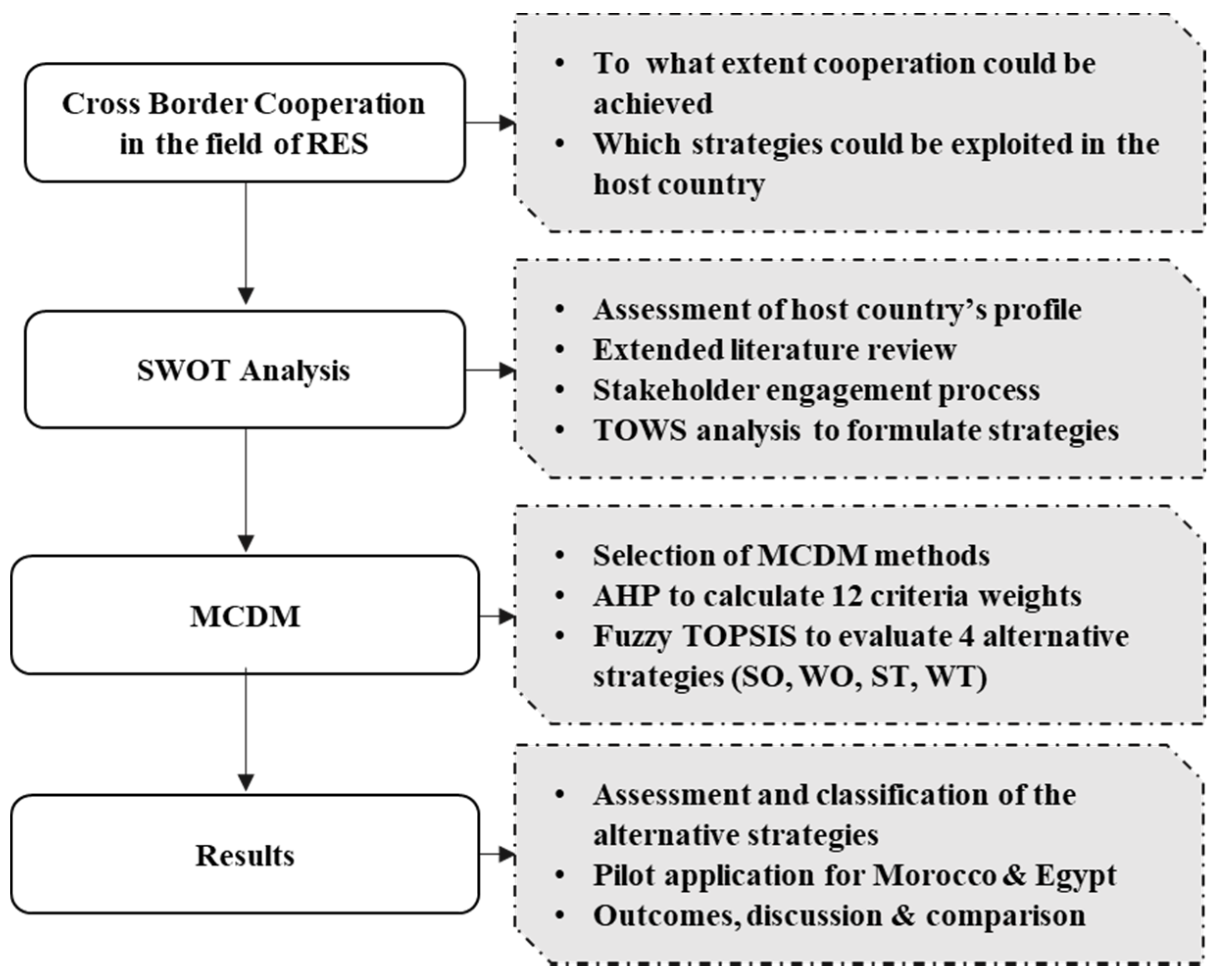
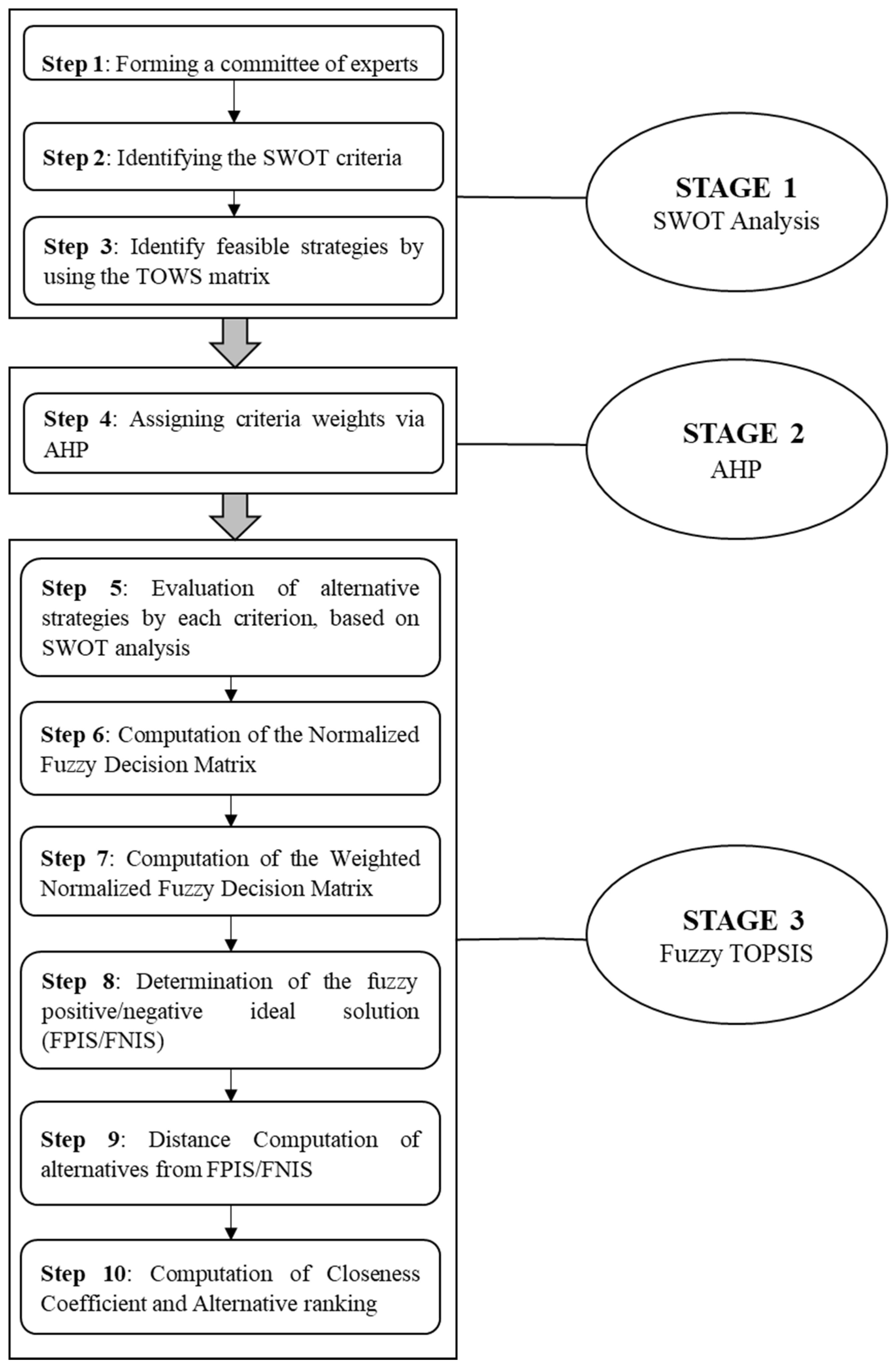
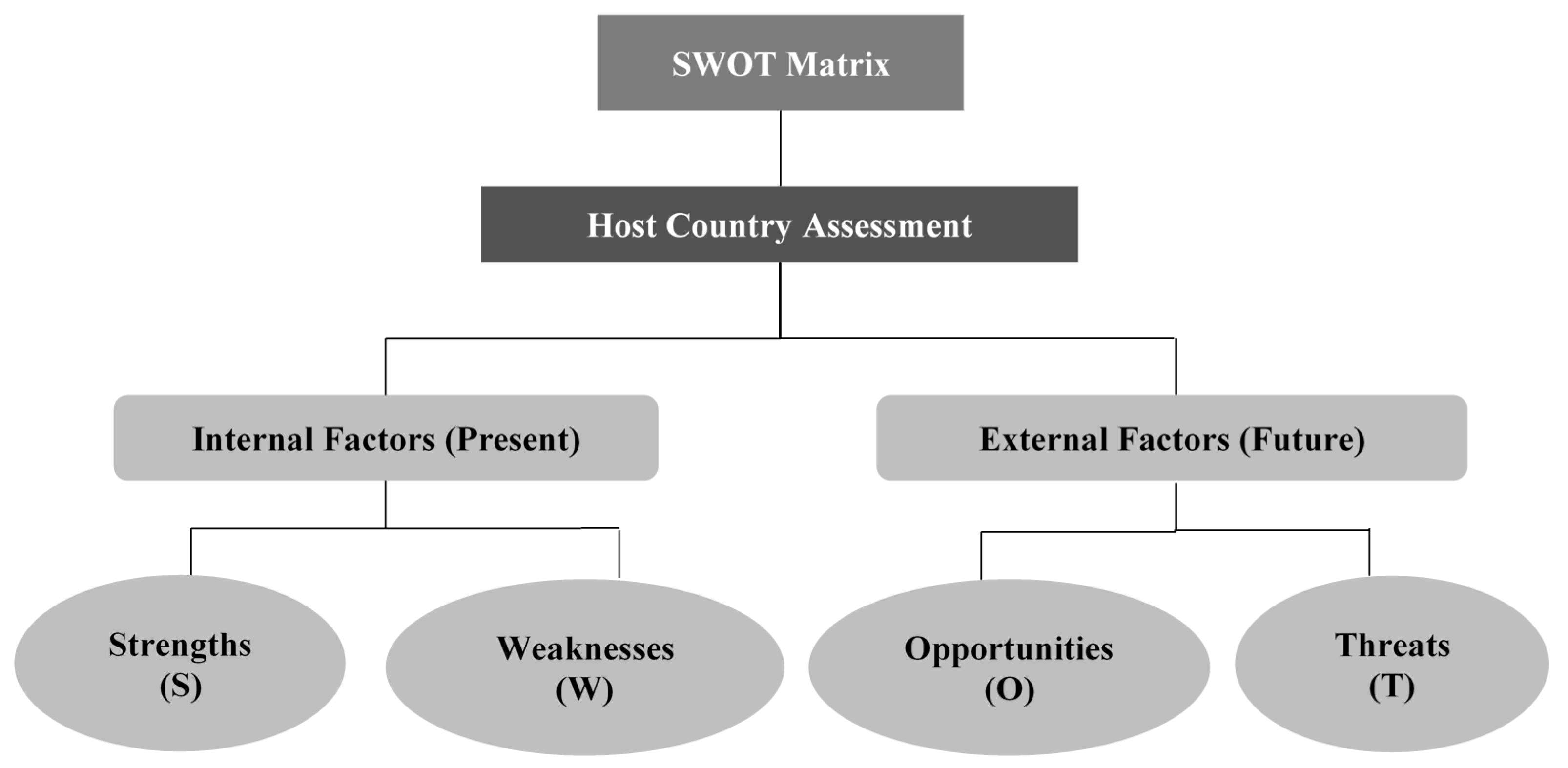
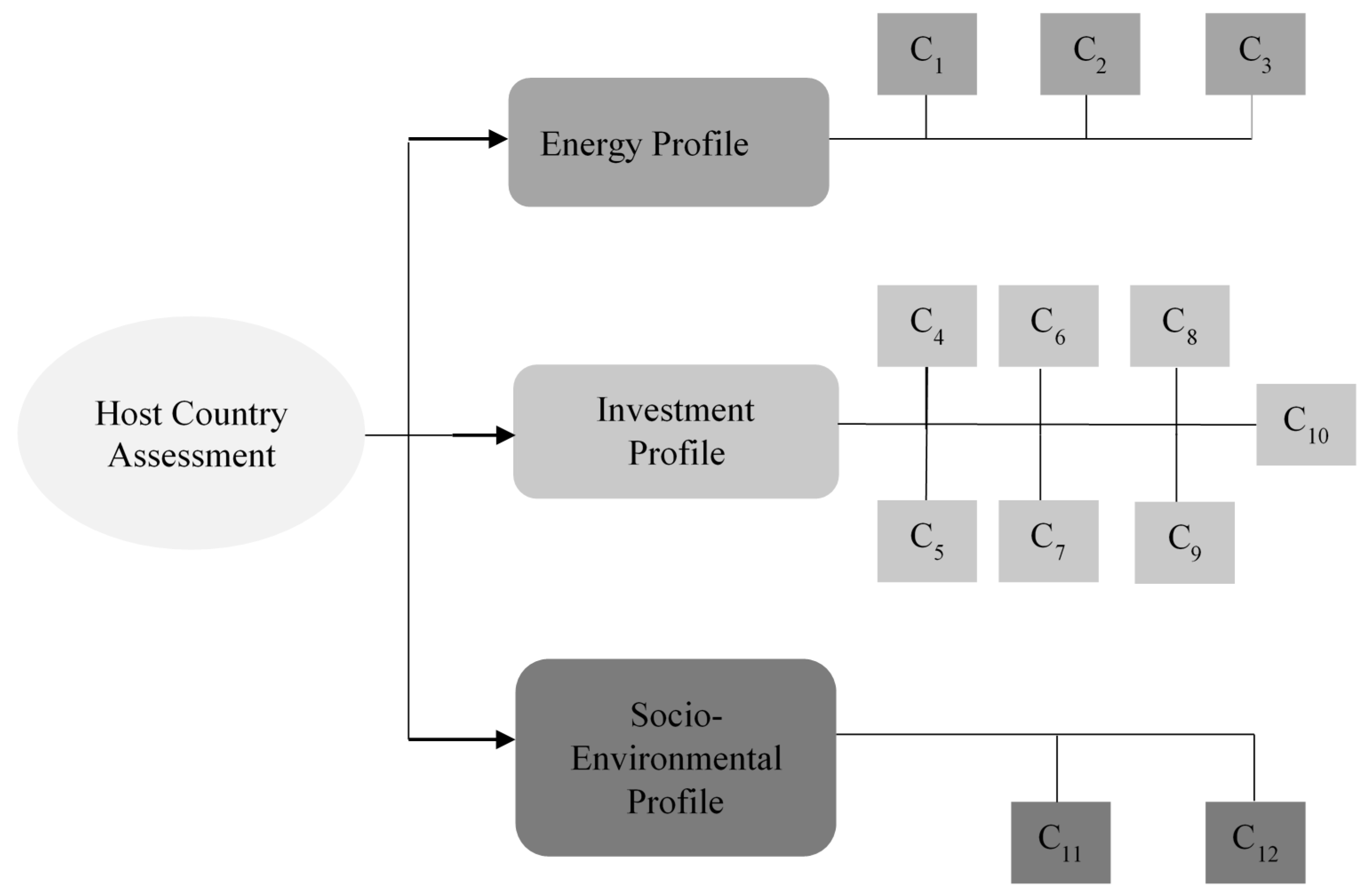
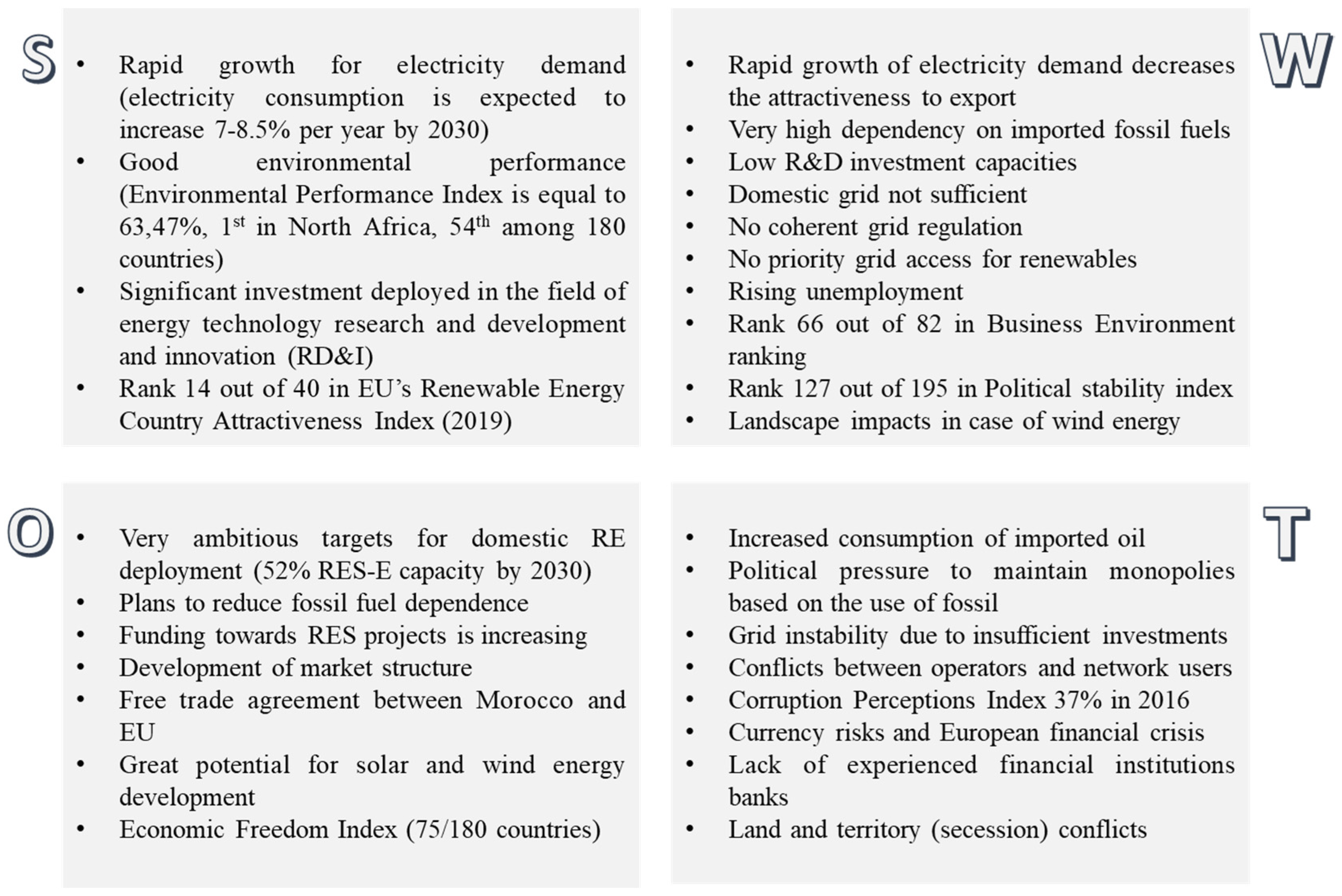
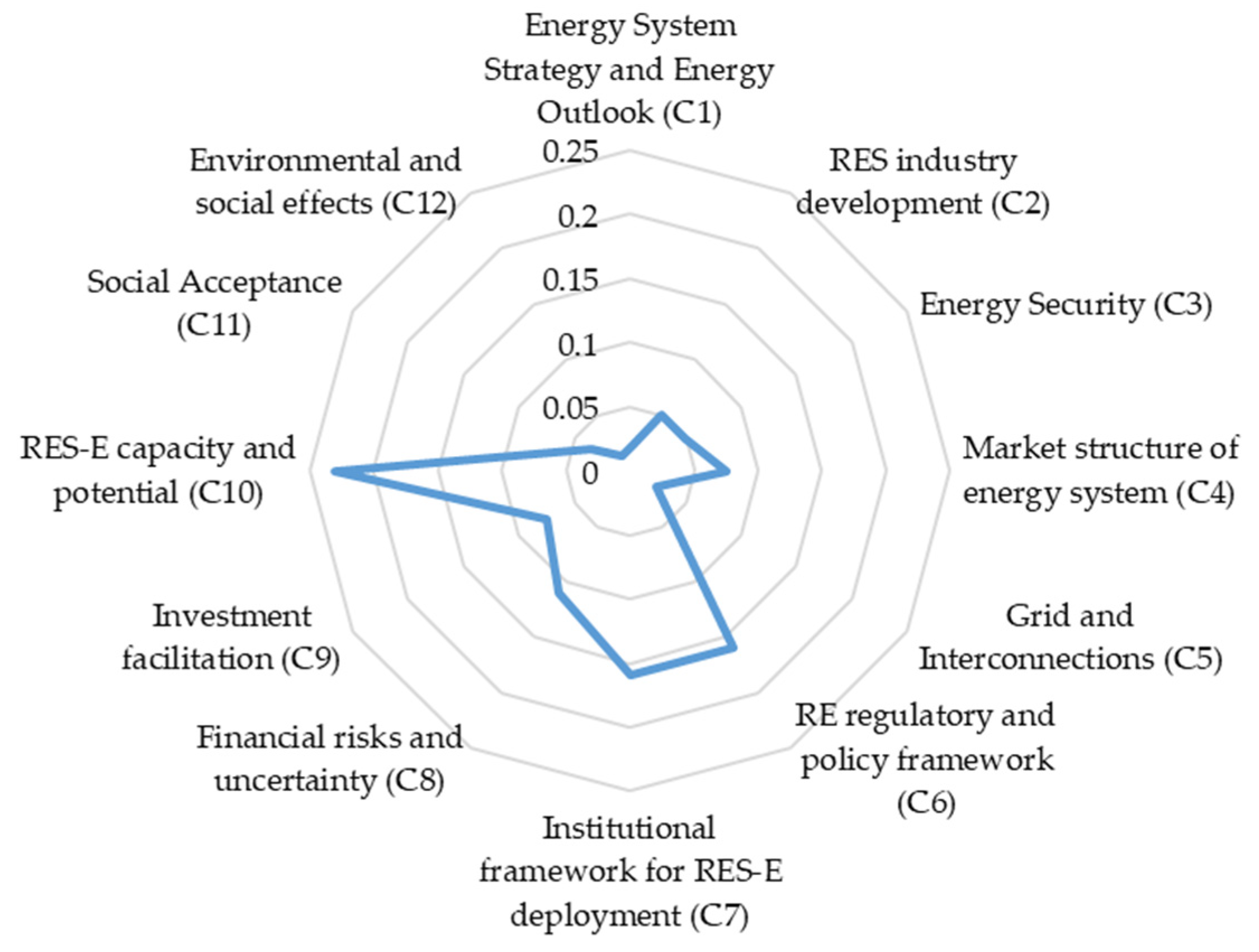
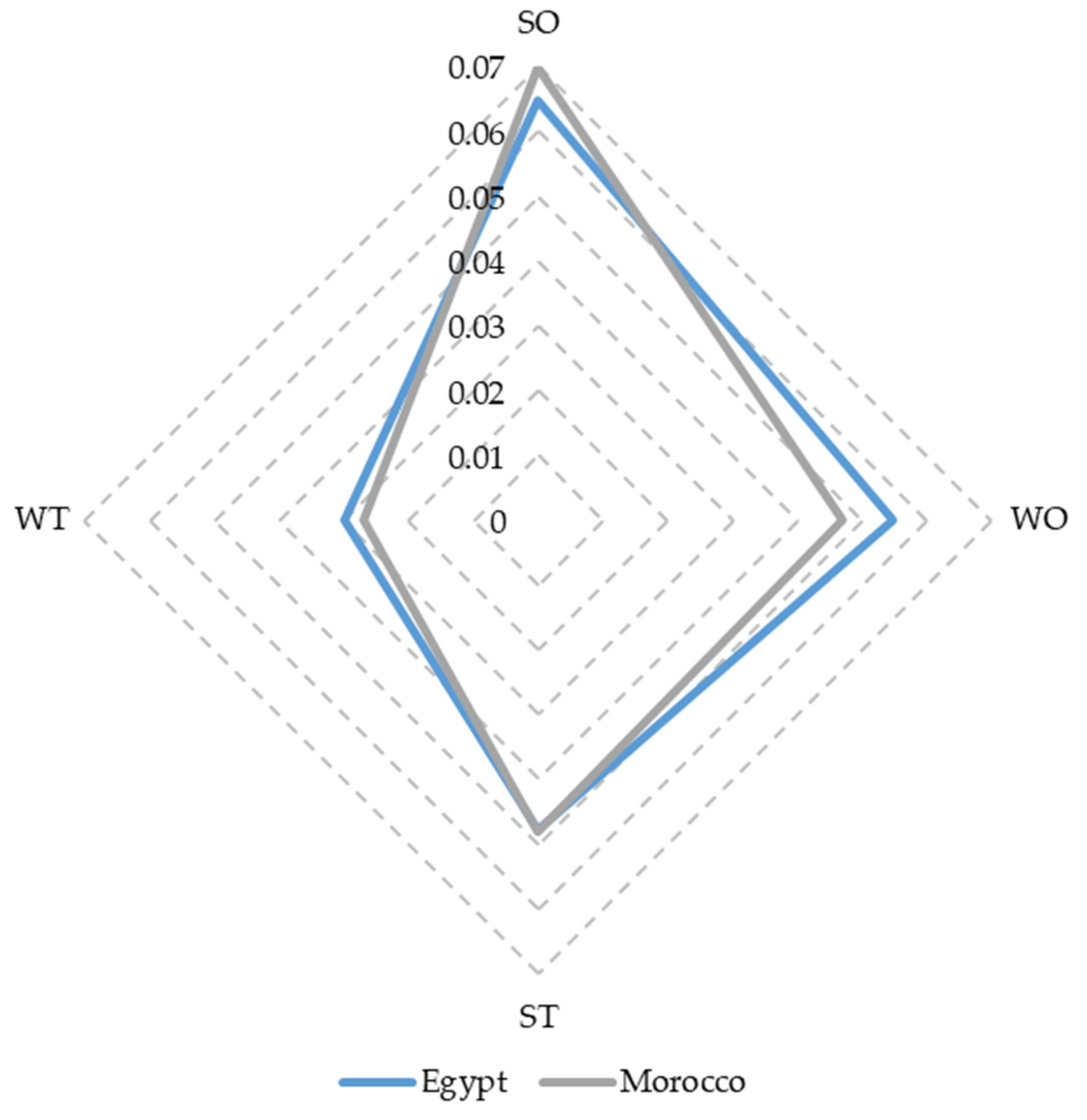
| Internal Factors | |||
|---|---|---|---|
| Strengths (S) | Weaknesses (W) | ||
| External Factors | Opportunities (O) | SO Strategy | WO Strategy |
| Threats (T) | ST Strategy | WT Strategy | |
| Definition | Intensely of Importance |
|---|---|
| Equally important | 1 |
| Moderately more important | 3 |
| Strongly more important | 5 |
| Very strong more important | 7 |
| Extremely more important | 9 |
| Intermediate more important | 2,4,6,8 |
| Linguistic Variables for The Ratings | |
|---|---|
| Linguistic Variables | Fuzzy Numbers |
| Very Poor (VP) | (0, 0, 1) |
| Poor (P) | (0, 1, 3) |
| Medium Poor (MP) | (1, 3, 5) |
| Fair (F) | (3, 5, 7) |
| Medium Good (MG) | (5, 7, 9) |
| Good (G) | (7, 9, 10) |
| Very Good (VG) | (9, 10, 10) |
| Ci | C1 | C2 | C3 | C4 | C5 | C6 | C7 | C8 | C9 | C10 | C11 | C12 |
|---|---|---|---|---|---|---|---|---|---|---|---|---|
| C1 | 1 | 1/4 | 1/4 | 1/5 | 1/2 | 1/7 | 1/7 | 1/6 | 1/5 | 1/8 | 1/3 | 2 |
| C2 | 4 | 1 | 1 | 1/2 | 3 | 1/4 | 1/4 | 1/3 | 1/2 | 1/5 | 2 | 5 |
| C3 | 4 | 1 | 1 | 1/2 | 3 | 1/4 | 1/4 | 1/3 | 1/2 | 1/5 | 2 | 5 |
| C4 | 5 | 2 | 2 | 1 | 4 | 1/3 | 1/3 | 1/2 | 1 | 1/4 | 3 | 6 |
| C5 | 2 | 1/3 | 1/3 | 1/4 | 1 | 1/6 | 1/6 | 1/5 | 1/4 | 1/7 | 1/2 | 3 |
| C6 | 7 | 4 | 4 | 3 | 6 | 1 | 1 | 2 | 3 | 1/2 | 5 | 8 |
| C7 | 7 | 4 | 4 | 3 | 6 | 1 | 1 | 2 | 3 | 1/2 | 5 | 8 |
| C8 | 6 | 3 | 3 | 2 | 5 | 1/2 | 1/2 | 1 | 2 | 1/3 | 4 | 7 |
| C9 | 5 | 2 | 2 | 1 | 4 | 1/3 | 1/3 | 1/2 | 1 | 1/4 | 3 | 6 |
| C10 | 8 | 5 | 5 | 4 | 7 | 2 | 2 | 3 | 4 | 1 | 6 | 9 |
| C11 | 3 | 1/2 | 1/2 | 1/3 | 2 | 1/5 | 1/5 | 1/4 | 1/3 | 1/6 | 1 | 4 |
| C12 | 1/2 | 1/5 | 1/5 | 1/6 | 1/3 | 1/8 | 1/8 | 1/7 | 1/6 | 1/9 | 1/4 | 1 |
| Ci | C1 | C2 | C3 | C4 | C5 | C6 | C7 | C8 | C9 | C10 | C11 | C12 |
|---|---|---|---|---|---|---|---|---|---|---|---|---|
| C1 | 0.019 | 0.011 | 0.011 | 0.013 | 0.012 | 0.023 | 0.023 | 0.016 | 0.013 | 0.033 | 0.010 | 0.031 |
| C2 | 0.076 | 0.043 | 0.043 | 0.031 | 0.072 | 0.040 | 0.040 | 0.032 | 0.031 | 0.053 | 0.062 | 0.078 |
| C3 | 0.076 | 0.043 | 0.043 | 0.031 | 0.072 | 0.040 | 0.040 | 0.032 | 0.031 | 0.053 | 0.062 | 0.078 |
| C4 | 0.095 | 0.086 | 0.086 | 0.063 | 0.100 | 0.053 | 0.053 | 0.048 | 0.063 | 0.066 | 0.094 | 0.094 |
| C5 | 0.038 | 0.014 | 0.014 | 0.016 | 0.023 | 0.026 | 0.026 | 0.019 | 0.016 | 0.038 | 0.016 | 0.047 |
| C6 | 0.133 | 0.172 | 0.172 | 0.188 | 0.143 | 0.159 | 0.159 | 0.192 | 0.188 | 0,132 | 0.156 | 0.125 |
| C7 | 0.133 | 0.172 | 0.172 | 0.188 | 0.143 | 0.159 | 0.159 | 0.192 | 0,188 | 0.132 | 0.156 | 0.125 |
| C8 | 0.114 | 0.129 | 0.129 | 0.125 | 0.120 | 0.079 | 0.079 | 0.096 | 0.125 | 0.088 | 0.125 | 0.109 |
| C9 | 0.095 | 0.086 | 0.086 | 0.063 | 0.100 | 0.053 | 0.053 | 0.048 | 0.063 | 0.066 | 0.094 | 0.094 |
| C10 | 0.152 | 0.215 | 0.215 | 0.251 | 0.167 | 0.317 | 0.317 | 0.288 | 0.251 | 0.265 | 0.187 | 0.141 |
| C11 | 0.057 | 0.021 | 0.021 | 0.021 | 0.048 | 0.032 | 0.032 | 0.024 | 0.021 | 0.044 | 0.031 | 0.063 |
| C12 | 0.01 | 0.009 | 0.009 | 0.010 | 0.008 | 0.020 | 0.020 | 0.014 | 0.010 | 0.030 | 0.008 | 0.016 |
| Criteria | wi | λmax | RI | CI | CR |
|---|---|---|---|---|---|
| C1 | 1.8% | 12.68 | 1.54 | 0.062 | 0.04 |
| C2 | 5% | ||||
| C3 | 5% | ||||
| C4 | 7.5% | ||||
| C5 | 2.4% | ||||
| C6 | 16% | ||||
| C7 | 16% | ||||
| C8 | 11% | ||||
| C9 | 7.5% | ||||
| C10 | 23% | ||||
| C11 | 3.5% | ||||
| C12 | 1.3% |
| Criteria | Weight | Final Rank |
|---|---|---|
| RES-E capacity and potential (C10) | 0.23 | 1 |
| RE regulatory and policy framework (C6) | 0.16 | 2 |
| Institutional framework for RES-E deployment (C7) | 0.16 | 2 |
| Financial risks and uncertainty (C8) | 0.11 | 3 |
| Market structure of energy system (C4) | 0.075 | 4 |
| Investment facilitation (C9) | 0.075 | 4 |
| RES industry development (C2) | 0.05 | 5 |
| Energy Security (C3) | 0.05 | 5 |
| Social Acceptance (C11) | 0.035 | 6 |
| Grid and Interconnections (C5) | 0.024 | 7 |
| Energy System Strategy and Energy Outlook (C1) | 0.018 | 8 |
| Environmental and social effects (C12) | 0.013 | 9 |
| Criteria | SO | WO | ST | WT |
|---|---|---|---|---|
| C1 | VG | G | F | MG |
| C2 | MG | F | MP | F |
| C3 | MG | MP | MP | F |
| C4 | MG | F | P | VP |
| C5 | VG | F | MG | MP |
| C6 | G | MP | MG | MP |
| C7 | G | MG | F | P |
| C8 | MG | F | F | MP |
| C9 | MG | MP | F | P |
| C10 | G | MG | MG | MP |
| C11 | F | MP | MP | F |
| C12 | MG | MP | F | F |
| Criteria | SO | WO | ST | WT |
|---|---|---|---|---|
| C1 | (9, 10, 10) | (7, 9, 10) | (3, 5, 7) | (5, 7, 9) |
| C2 | (5, 7, 9) | (3, 5, 7) | (1, 3, 5) | (3, 5, 7) |
| C3 | (5, 7, 9) | (1, 3, 5) | (1, 3, 5) | (3, 5, 7) |
| C4 | (5, 7, 9) | (3, 5, 7) | (0, 1, 3) | (0, 0, 1) |
| C5 | (9, 10, 10) | (3, 5, 7) | (5, 7, 9) | (1, 3, 5) |
| C6 | (7, 9, 10) | (1, 3, 5) | (5, 7, 9) | (1, 3, 5) |
| C7 | (7, 9, 10) | (5, 7, 9) | (3, 5, 7) | (0, 1, 3) |
| C8 | (5, 7, 9) | (3, 5, 7) | (3, 5, 7) | (1, 3, 5) |
| C9 | (5, 7, 9) | (1, 3, 5) | (3, 5, 7) | (0, 1, 3) |
| C10 | (7, 9, 10) | (5, 7, 9) | (5, 7, 9) | (1, 3, 5) |
| C11 | (3, 5, 7) | (1, 3, 5) | (1, 3, 5) | (3, 5, 7) |
| C12 | (5, 7, 9) | (1, 3, 5) | (3, 5, 7) | (3, 5, 7) |
| Criteria | SO | WO | ST | WT |
|---|---|---|---|---|
| C1 | (0.9, 1, 1) | (0.7, 0.9, 1) | (0.3, 0.5, 0.7) | (0.5, 0.7, 0.9) |
| C2 | (0.55, 0.77, 1) | (0.33, 0.55, 0.77) | (0.11, 0.33, 0.55) | (0.33, 0.55, 0.77) |
| C3 | (0.55, 0.77, 1) | (0.11, 0.33, 0.55) | (0.11, 0.33, 0.55) | (0.33, 0.55, 0.77) |
| C4 | (0.55, 0.77, 1) | (0.33, 0.55, 0.77) | (0, 0.11, 0.33) | (0, 0, 0.11) |
| C5 | (0.9, 1, 1) | (0.3, 0.5, 0.7) | (0.5, 0.7, 0.9) | (0.1, 0.3, 0.5) |
| C6 | (0.7, 0.9, 1) | (0.1, 0.3, 0.5) | (0.5, 0.7, 0.9) | (0.1, 0.3, 0.5) |
| C7 | (0.7, 0.9, 1) | (0.5, 0.7, 0.9) | (0.3, 0.5, 0.7) | (0, 0.1, 0.3) |
| C8 | (0.55, 0.77, 1) | (0.33, 0.55, 0.77) | (0.33, 0.55, 0.77) | (0.11, 0.33, 0.55) |
| C9 | (0.55, 0.77, 1) | (0.11, 0.33, 0.55) | (0.33, 0.55, 0.77) | (0, 0.11, 0.33) |
| C10 | (0.7, 0.9, 1) | (0.5, 0.7, 0.9) | (0.5, 0.7, 0.9) | (0.1, 0.3, 0.5) |
| C11 | (0.42, 0.71, 1) | (0.14, 0.42, 0.71) | (0.14, 0.42, 0.71) | (0.42, 0.71, 1) |
| C12 | (0.55, 0.77, 1) | (0.11, 0.33, 0.55) | (0.33, 0.55, 0.77) | (0.33, 0.55, 0.77) |
| Criteria | SO | WO | ST | WT |
|---|---|---|---|---|
| C1 | (0.016, 0.018, 0.018) | (0.013, 0.016, 0.018) | (0.005, 0.009, 0.013) | (0.009, 0.013, 0.016) |
| C2 | (0.028, 0.039, 0.050) | (0.017, 0.028, 0.039) | (0.006, 0.017, 0.028) | (0.017, 0.028, 0.039) |
| C3 | (0.028, 0.039, 0.050) | (0.006, 0.017, 0.028) | (0.006, 0.017, 0.028) | (0.017, 0.028, 0.039) |
| C4 | (0.041, 0.058, 0.075) | (0.025, 0.041, 0.058) | (0.000, 0.008, 0.025) | (0.000, 0.000, 0.008) |
| C5 | (0.022, 0.024, 0.024) | (0.007, 0.012, 0.017) | (0.012, 0.017, 0.022) | (0.002, 0.007, 0.012) |
| C6 | (0.112, 0.144, 0.160) | (0.016, 0.048, 0.080) | (0.080, 0.112, 0.144) | (0.016, 0.048, 0.080) |
| C7 | (0.112, 0.144, 0.160) | (0.080, 0.112, 0.144) | (0.048, 0.080, 0.112) | (0.000, 0.016, 0.048) |
| C8 | (0.061, 0.085, 0.110) | (0.036, 0.061, 0.085) | (0.036, 0.061, 0.085) | (0.012, 0.036, 0.061) |
| C9 | (0.041, 0.058, 0.075) | (0.008, 0.025, 0.041) | (0.025, 0.041, 0.058) | (0.000, 0.008, 0.025) |
| C10 | (0.161, 0.207, 0.230) | (0.115, 0.161, 0.207) | (0.115, 0.161, 0.207) | (0.023, 0.069, 0.115) |
| C11 | (0.015, 0.025, 0.035) | (0.005, 0.015, 0.025) | (0.005, 0.015, 0.025) | (0.015, 0.025, 0.035) |
| C12 | (0.007, 0.010, 0.013) | (0,001, 0,004, 0,007) | (0,004, 0,007, 0,010) | (0.004, 0.007, 0.010) |
| Criteria | SO | WO | ST | WT |
|---|---|---|---|---|
| C1 | 0.983 | 0.984 | 0.991 | 0.987 |
| C2 | 0.961 | 0.973 | 0.984 | 0.973 |
| C3 | 0.961 | 0.984 | 0.984 | 0.973 |
| C4 | 0.942 | 0.959 | 0.989 | 0.997 |
| C5 | 0.977 | 0.988 | 0.983 | 0.993 |
| C6 | 0.862 | 0.952 | 0.888 | 0.952 |
| C7 | 0.862 | 0,888 | 0.920 | 0.979 |
| C8 | 0.915 | 0.940 | 0.940 | 0.964 |
| C9 | 0.942 | 0.975 | 0.959 | 0.989 |
| C10 | 0.801 | 0.840 | 0.840 | 0.932 |
| C11 | 0.979 | 0.985 | 0.982 | 0.987 |
| C12 | 0.990 | 0.996 | 0.993 | 0.993 |
| A* | 11.175 | 11.464 | 11.453 | 11.719 |
| Criteria | SO | WO | ST | WT |
|---|---|---|---|---|
| C1 | 0.017 | 0.016 | 0.009 | 0.013 |
| C2 | 0.040 | 0.029 | 0.019 | 0.029 |
| C3 | 0.040 | 0.019 | 0.019 | 0.029 |
| C4 | 0.060 | 0.043 | 0.015 | 0.005 |
| C5 | 0.023 | 0.013 | 0.017 | 0.008 |
| C6 | 0.140 | 0.055 | 0.115 | 0.055 |
| C7 | 0.140 | 0.115 | 0.084 | 0.029 |
| C8 | 0.087 | 0.064 | 0.064 | 0.041 |
| C9 | 0.060 | 0.028 | 0.043 | 0.015 |
| C10 | 0.201 | 0.165 | 0.165 | 0.079 |
| C11 | 0.022 | 0.017 | 0.022 | 0.017 |
| C12 | 0.010 | 0.005 | 0.008 | 0.008 |
| A- | 0.840 | 0.569 | 0.580 | 0.328 |
| Ranking | Ai | Alternative Strategies | Closeness Coefficient |
|---|---|---|---|
| 1 | A1 | SO | 0.07 |
| 3 | A2 | WO | 0.047 |
| 2 | A3 | ST | 0.048 |
| 4 | A4 | WT | 0.027 |
| Criteria | SO | WO | ST | WT |
|---|---|---|---|---|
| C1 | VG | G | MG | F |
| C2 | MG | F | F | MG |
| C3 | F | MG | P | F |
| C4 | G | F | MG | MP |
| C5 | VG | MG | F | F |
| C6 | MG | MG | F | MP |
| C7 | F | MG | MP | P |
| C8 | MG | MP | F | MG |
| C9 | MG | MP | MG | F |
| C10 | G | MG | MG | VP |
| C11 | MG | MG | F | P |
| C12 | F | P | VP | MG |
| Ranking | Ai | Alternative Strategies | Closeness Coefficient |
|---|---|---|---|
| 1 | A1 | SO | 0.0648 |
| 2 | A2 | WO | 0.0547 |
| 3 | A3 | ST | 0.0478 |
| 4 | A4 | WT | 0.030 |
© 2020 by the authors. Licensee MDPI, Basel, Switzerland. This article is an open access article distributed under the terms and conditions of the Creative Commons Attribution (CC BY) license (http://creativecommons.org/licenses/by/4.0/).
Share and Cite
Papapostolou, A.; Karakosta, C.; Apostolidis, G.; Doukas, H. An AHP-SWOT-Fuzzy TOPSIS Approach for Achieving a Cross-Border RES Cooperation. Sustainability 2020, 12, 2886. https://doi.org/10.3390/su12072886
Papapostolou A, Karakosta C, Apostolidis G, Doukas H. An AHP-SWOT-Fuzzy TOPSIS Approach for Achieving a Cross-Border RES Cooperation. Sustainability. 2020; 12(7):2886. https://doi.org/10.3390/su12072886
Chicago/Turabian StylePapapostolou, Aikaterini, Charikleia Karakosta, Georgios Apostolidis, and Haris Doukas. 2020. "An AHP-SWOT-Fuzzy TOPSIS Approach for Achieving a Cross-Border RES Cooperation" Sustainability 12, no. 7: 2886. https://doi.org/10.3390/su12072886
APA StylePapapostolou, A., Karakosta, C., Apostolidis, G., & Doukas, H. (2020). An AHP-SWOT-Fuzzy TOPSIS Approach for Achieving a Cross-Border RES Cooperation. Sustainability, 12(7), 2886. https://doi.org/10.3390/su12072886





